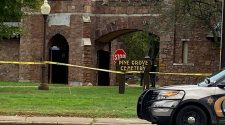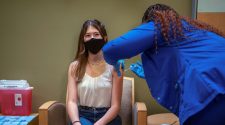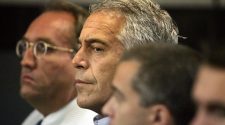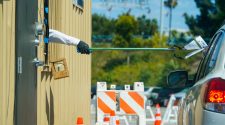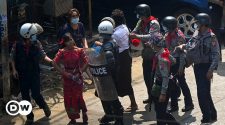The spread of COVID-19 is so pervasive that even a beefed-up state contact tracing apparatus probably won’t be enough to contain the spread of the virus, Hawaii Department of Health Director Bruce Anderson said Wednesday.
Anderson’s comments, made during a news conference at the Hawaii Convention Center, came a day after Gov. David Ige and Honolulu Mayor Kirk Caldwell announced new restrictions on gatherings, marking a new phase in the effort to control the virus.
Oahu continued to report new cases in the triple digits on Wednesday, with 234 of 261 cases reported statewide. It’s the continuation of a stunning increase in prevalence of the virus in a state that as recently as early June had significantly reduced COVID-19 with strict stay-at-home orders.
Department of Health Director Bruce Anderson acknowledged that the COVID-19 case count will have to drop for contact tracing to be effective.
Cory Lum/Civil Beat
Hawaii appeared to have so successfully quashed COVID-19 that some were discussing plans to open up to tourists this month — and to bill Hawaii as one of the world’s most COVID-free destinations, which at the time it was. Although most officials expected a rise in cases as the economy reopened, the state’s plan was to use extensive testing and contact tracing to contain the virus in clusters.
But that didn’t happen.
While some Department of Health officials have blamed the public for engaging in gatherings that allowed the virus to spread, others, including some health department staff, say it was the department’s fault for not hiring enough contact tracers when cases were low enough to be manageable.
Increasingly under fire from federal and state officials and business leaders, the department has announced efforts to hire more contact tracers. But now it seems the efforts will be less effective as a short-term solution to contain the virus, which has crippled the economy and cost the state tens of thousands of jobs. particularly in the tourism industry.
On Wednesday, Anderson acknowledged that Hawaii had missed the boat on contact tracing. The surge in cases is so pervasive, he said, that at this point tracing alone won’t do much good.
“No amount of contact tracing will contain the spike that we’ve seen,” Anderson said.
“What’s going to stop this disease from spreading in Hawaii is not the number of contact tracers, it’s going to be our behavior,” he said.
Specifically, he said, it will mean people keeping to themselves, not taking part in gatherings and other events that have let the virus spread.
“We will get the numbers down to a point where we can effectively deal with the issue,” Anderson said.
Anderson’s remarks came as officials made a push to show they are now significantly, although belatedly, stepping up the state’s contact tracing capacity. On hand with Anderson were Ige, Hawaii Emergency Management Agency director Kenneth Hara and Emily Roberson, who was recently hired to supervise contact tracing as chief of the department’s Disease Investigation Branch.
Anderson said the department now has about 126 contact tracers statewide, including 96 on Oahu, and 13 supervisors and administrative support personnel. Before the press briefing, news photographers were allowed to see some of the new contact tracers during a photo opportunity in a Convention Center ballroom that had been set up with work stations for about 50 people. Reporters weren’t allowed into the room, and the photographers weren’t allowed to talk to anyone.
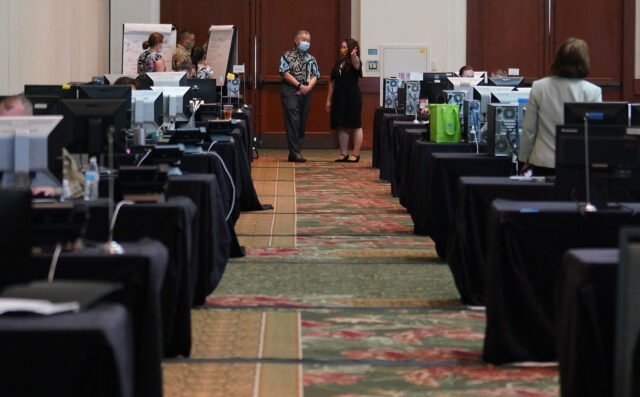
Emily Roberson, chief of the Disease Investigation Branch, and Gov. David Ige showed off a room at the Hawaii Convention Center where health department contact tracers will be housed.
Cory Lum/Civil Beat
In essence, Hawaii is back to where it was in late March, as Ige, Caldwell and the other county mayors first began issuing orders to shut down activities.
This time, though, officials are using a far more nuanced approach to quell a virus that is far more prevalent.
Instead of strict stay-at-home orders that closed all but essential businesses, which succeeded in quelling the virus last time, Ige and Caldwell’s new strategy aims to stop the spread by preventing people from gathering in groups larger than five people, even if they’re from the same household. Businesses like restaurants, gyms, salons and water parks will remain open.
Lt. Gov. Josh Green, who closely tracks the virus spread as well as the state’s capacity to handle it, believes the strategy has about a 50% chance of succeeding in getting the new case count down to a manageable level. In the meantime, he blames Anderson and Dr. Sarah Park, the state epidemiologist who previously oversaw contact tracing, for not ramping up contact tracing when it had a chance to contain the virus.
“I hope that they learned their lesson; however, there will be casualties because they didn’t they take action for the better part of three months,” Green said.




